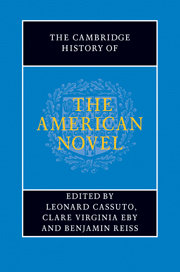Book contents
- Frontmatter
- General Introduction
- PART ONE INVENTING THE AMERICAN NOVEL
- Introduction: inventing the American novel
- 1 Transatlantic currents and the invention of the American novel
- 2 Susanna Rowson, Hannah Webster Foster, and the seduction novel in the early US
- 3 Charles Brockden Brown and the novels of the early republic
- 4 The novel in the antebellum book market
- 5 American land, American landscape, American novels
- 6 Cooper and the idea of the Indian
- 7 The nineteenth-century historical novel
- 8 Hawthorne and the aesthetics of American romance
- 9 Melville and the novel of the sea
- 10 Religion and the nineteenth-century American novel
- 11 Manhood and the early American novel
- 12 Sentimentalism
- 13 Supernatural novels
- 14 Imagining the South
- 15 Stowe, race, and the antebellum American novel
- 16 The early African American novel
- PART TWO REALISM, PROTEST, ACCOMMODATION
- PART THREE MODERNISM AND BEYOND
- PART FOUR CONTEMPORARY FORMATIONS
- A selected bibliography
- Index
Introduction: inventing the American novel
from PART ONE - INVENTING THE AMERICAN NOVEL
Published online by Cambridge University Press: 28 July 2011
- Frontmatter
- General Introduction
- PART ONE INVENTING THE AMERICAN NOVEL
- Introduction: inventing the American novel
- 1 Transatlantic currents and the invention of the American novel
- 2 Susanna Rowson, Hannah Webster Foster, and the seduction novel in the early US
- 3 Charles Brockden Brown and the novels of the early republic
- 4 The novel in the antebellum book market
- 5 American land, American landscape, American novels
- 6 Cooper and the idea of the Indian
- 7 The nineteenth-century historical novel
- 8 Hawthorne and the aesthetics of American romance
- 9 Melville and the novel of the sea
- 10 Religion and the nineteenth-century American novel
- 11 Manhood and the early American novel
- 12 Sentimentalism
- 13 Supernatural novels
- 14 Imagining the South
- 15 Stowe, race, and the antebellum American novel
- 16 The early African American novel
- PART TWO REALISM, PROTEST, ACCOMMODATION
- PART THREE MODERNISM AND BEYOND
- PART FOUR CONTEMPORARY FORMATIONS
- A selected bibliography
- Index
Summary
Sandra Gustafson's chapter in this section begins with the image of a map of North America in 1715 that shows the familiar British colonies abutting territories identified as French, Spanish, Iroquois, Apachee, Kikapou, Illinese, Esquimaux, Mozeemleck, and even Danish – picturing “a mixture of the familiar, the less familiar, the unknown, and the fantastic.” The map is a fitting backdrop not only for the novels of James Fenimore Cooper, the main subject of her chapter, but also for other fictional works that attempted to bring order to the chaotic and often violent conditions of life in the New World.
The map can also remind us that while literary historians – and a great many novelists themselves – have long seen the development of the novel as tied up with the history of nations, both nations and novels have origins far more complex than any simple linear narrative or national map can convey. And so while the hunt for the origins of the American novel has tended to stress indigenous forms, themes, settings, and other patterns that reinforce exceptionalist models of US literary history, we do best, as Paul Giles suggests in the opening chapter of this book, to map the American novel onto a broader swath of the globe. Specifically, Giles argues, “cultural traffic across the Atlantic in both directions” shaped a number of literary conventions, themes, and formats out of which later critics and writers would try to find patterns suggestive of a national tradition.
- Type
- Chapter
- Information
- The Cambridge History of the American Novel , pp. 15 - 21Publisher: Cambridge University PressPrint publication year: 2011



